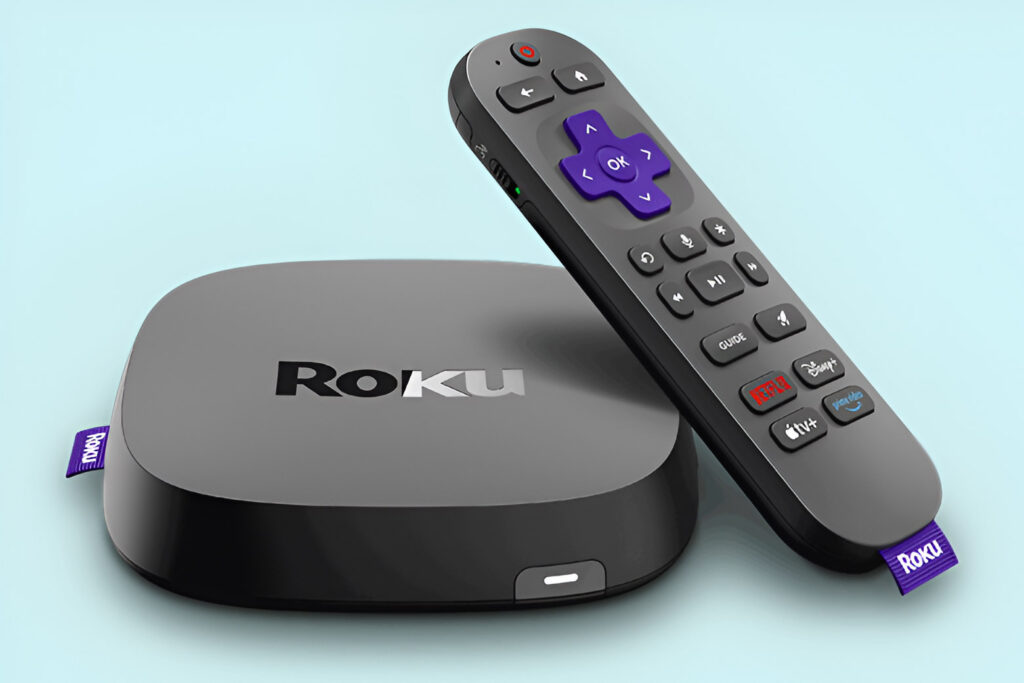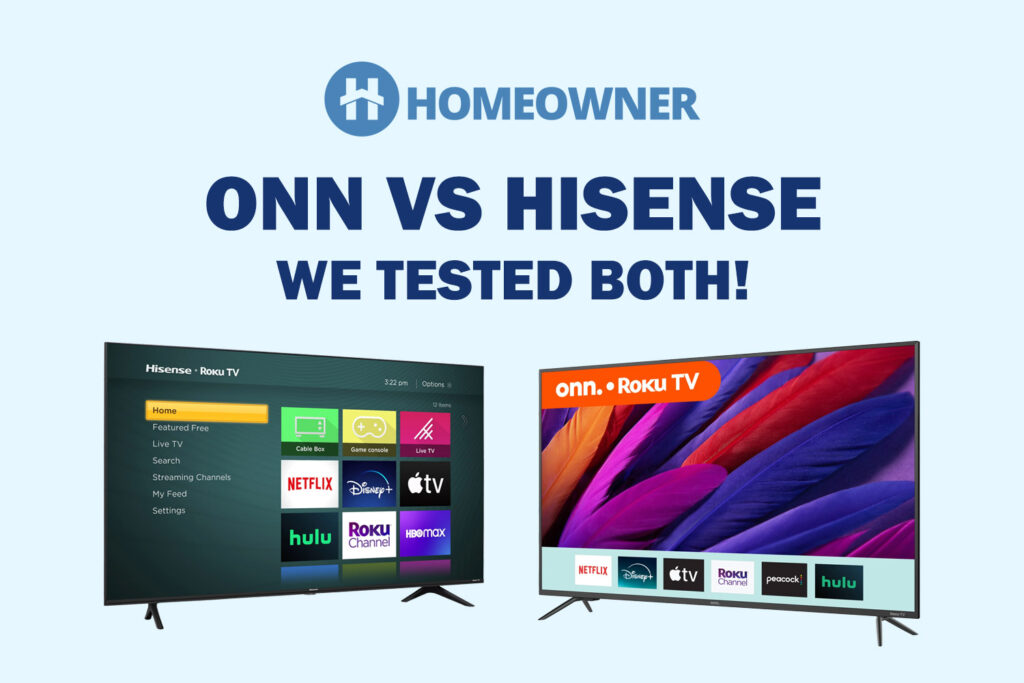In this post:
- 8 Best WiFi Routers of 2025 [Top Picks]
- 1. Best for Gaming: ASUS ROG GT-AXE16000
- 2. Best for Streaming: Netgear Nighthawk RAXE300
- 3. Best for Gigabit Internet: TP-Link Archer AXE75
- 4. Best Dual-Band Router: ASUS RT-AX88U Pro
- 5. Best Mesh WiFi Router: Eero Pro 6E
- 6. Most Secure Router: Synology RT6600ax
- 7. Best for Work From Home: Linksys Hydra 6
- 8. Best for 100-300 Mbps: TP-Link Archer AX55 Pro
- Frequently Asked Questions
- Verdict
Evolving internet needs mean choosing a router that is best fit for both you and your wallet. But the availability of many options has made the selection trickier than ever.
Other than paraded speeds and range, there’s much more to consider. These include the connection capacity, number & type of ports, security, etc. Evaluating devices on these seems like a Sisyphean task, and this is where I come in.
Based on my 8 years of experience testing offerings from all popular manufacturers, I've curated a list of the top options available as of now.
8 Best WiFi Routers of 2025 [Top Picks]
All the devices included in the list have gone through my weeklong tests, where evaluation is based on multiple factors like speed, range, port setup, security, and others. So you can trust them with closed eyes.
Besides, I’ve included multiple choices, from high-end to mid-range and even budget options. Irrespective of your needs, this article has you covered.
1. Best for Gaming: ASUS ROG GT-AXE16000
- World's first quad-band WiFi 6E gaming router – Ultrafast WiFi 6E (802.11ax) quad-band WiFi router boosts speeds up to 16000 Mbps.Power Supply : AC Input : 110V-240V(50-60Hz), DC Output : 19 V with max. 3.42 A current ; 19.5 V with max. 3.33 A current.
- New 6 GHz frequency band – Wider channels and higher capacity delivers higher performance, lower latency, and less interference.
- Expanded coverage – The exclusive ASUS RangeBoost Plus improves signal range and overall coverage.
- Dual 10G ports – Enjoy up to 10X-faster data-transfer speeds for bandwidth-demanding tasks with two 10 Gbps WAN/LAN ports.
- 2.5G WAN port – 2.5 Gbps port prioritizes all network traffic, and unlocks the full potential of WiFi 6.
ASUS ROG GT-AXE16000, taking the top spot, is a high-end gaming router with top-shelf specifications and highly promising performance.
Belonging to a rare family of Quad-Band routers, it brings two 10G LAN/WAN ports, a massive throughput capacity, a long WiFi range, advanced security tools, and gaming-friendly features.
Speeds & Performance
The beast by Asus comes with a quad-band WiFi 6E setup with a maximum throughput capacity of 16000 Mbps, which is split between each band as follows:
| 6 GHz: 4804 Mbps | 5 GHz (1): 4804 Mbps | 5 GHz (2): 4804 Mbps | 2.4 GHz: 1148 Mbps |
Courtesy of an additional 6 GHz and two 5 GHz bands, the resulting throughput with AT&T's 2 Gbps internet plan was really fast.
Upon performing a speed test at a short distance of 25 feet, my WiFi 6E supported laptop, the downloads could clock at a maximum of 1.76 Gbps, while uploads averaged at 1.54 Gbps.

Moving on to the long-distance test in the meeting room at about 50 feet, the routing unit was mowed down the competition, averaging around 1.26 Gbps and 987 Mbps for downloads and uploads, respectively.
From a quality perspective, GT-AXE16000 delivered excellent WiFi stability, and I didn’t notice any hiccups during my test period. I could stream 4K videos and play online games on four different devices without any lags or latencies.
WiFi Coverage & Devices Capacity
Coverage-wise, GT-AXE16000 is one of the extended range options, with a stipulated value of 3,500 Sq Ft. Courtesy of its eight powerful antennae, the transmitted signals could travel across my 2,500 Sq Ft lab with ease.
Not only that, but the beamforming tech ensures signals are stable even in corners, enabling uninterrupted transmission. Coupled with MU-MIMO and OFDMA, the device ensures signals of equal strength are transmitted into connected devices.
Over the space, I could establish up to 85 smart devices, which is far away from the manufacturer’s claim of 200 but enough for a mid-sized corporate establishment.
Security Features
The GT-AXE16000 comes with AiProtection Pro, an advanced security suite that offers real-time protection against malware-infected websites and scam pages. During my testing, it blocked many pages, and I received a warning message.
Other than that, it lets me block a category of websites for certain users and limit internet usage. These are quite handy features to have, and the best part is that you don’t need to pay anything for them anytime.
Ports & Connectivity
The GT-AXE16000 comes with two 10G Ethernet ports, which, although applicable for respective internet plans, are offered by limited providers. I, however, didn’t have access to such, had the 2 Gbps plan, and established a wired connection with available 2.5G WAN ports, where downloads maxed out at 1.95 Gbps.
Not to mention, the gaming performance was off the charts, and Overwatch played out at 5ms ping and 148 FPS consistently. Other than that, GT-AXE16000 entails the latest USB 3.2 port for faster file transfers.
Conclusion
Asus ROG GT-AXE16000 is a high-performance router for gaming that, courtesy of quad-band support and two 10G ports, made huge bounds in terms of performance. Aside from that, its lifetime free advanced security features are a huge addition.
If you’re looking for the absolute best possible wireless router, this is it.
Pros
- Quad-band support
- Impressive wireless performance
- One 2.5G and two 10G ports
- Lifetime-free AiProtection security
- Great range and signal stability
- Connects more than 85 devices
Cons
- Expensive
2. Best for Streaming: Netgear Nighthawk RAXE300
- 6GHz WiFi band dedicated to WiFi 6E devices including Samsung Galaxy S21 Ultra 5G. Enjoy 4K/8K video streaming, AR/VR gaming and HD videoconferencing
- Powerful 1.7GHz quad-core processor gives you exceptional 7.8Gbps WiFi speed, 6.5x faster than WiFi 5. Backward compatible for all WiFi devices on 2.4GHz and 5GHz bands
- Coverage up to 2,500 sq. ft. and 40 devices
- NETGEAR devices come with security measures built in as well as enhanced safety features and updates designed to help protect you and your family
- Replace your existing WiFi Router (separate modem or modem router required). Compatible with any Internet Service Provider plan up to 1 Gigabit including cable, satellite, fiber, DSL and more
Next on my list is the Netgear Nighthawk RAXE300, which just misses the top spot with one less frequency band and lesser WiFi range but delivers top performance for both wireless and wired connections.
This WiFi 6E router has a massive throughput capacity, a multi-gig WAN/LAN, link aggregation support, and a better range than the Nighthawk RAX200.
Speeds & Performance
In terms of throughput, the Nighthawk RAXE300 is rated at AXE7800, which is split between its three operating bands as follows:
| 6 GHz: 2400 Mbps | 5 GHz: 4800 Mbps | 2.4 GHz: 600 Mbps |
As evident from the theoretical throughput, this Netgear piece delivers impressive performance when paired with my AT&T 2 Gbps plan.
In my short distance test of an unobstructed 20-feet distance from the source, it benchmarked 1.61 Gbps for downloads and 1.43 Gbps for uploads.

Data rates in a more typical household setup were around 1.46 Gbps and 1.29 Gbps for downloads and uploads, respectively.
Moving on, tests at 40 feet delivered decent results, with respective downloads and uploads maxing out at 1.12 Gbps and 961 Mbps. It, however, isn’t the fastest model I’ve tested, but it sure manages to stay neck-to-neck with my top recommendation.
Besides, quality-wise, the model didn’t disappoint. During my hours of testing, there weren’t any hiccups, and the online games & streams ran through lag-free.
WiFi Coverage & Devices Capacity
Netgear Nighthawk RAXE300 takes a step back to Asus GT-AXE16000 with a theoretical range of 2,500 Sq Ft. So how it’s good for real-world performance? To find out, I installed it centrally at my 1,500 Sq Ft home office and turned it on.
Without any surprise, the beamforming support helped it cover my entire home office. Paired with it, MU-MIMO and OFDMA work wonders when it comes to establishing simultaneous connections.
At one time, there were about 55 smart devices connected to a single bandwidth, and the best part was that there weren’t any lags or latencies.
Security Features
This is the area where Netgear has compromised despite the premium price. Although it has decent features, it should have come with a one-year complimentary subscription to Netgear Armor, just like we get on some select Nighthawk routers.
Nevertheless, the WPA3 encryption, VPN, SPI firewall, guest network, and auto-firmware update are there to protect your network.
Ports & Connectivity
RAXE300 isn’t as vast as my top pick for wired connectivity, but it sure has a lot in its bank. There’s a 2.5G WAN port that can handle internet plans up to 2500 Mbps, while there’s a single LAN/WAN and four LAN ports with Gigabit capacity.
The latter supports link aggregation, but you need two ISP plans to use that. Nevertheless, the wired connection delivers a whopping 1.94 Gbps download speeds, which makes for a no-nonsense gaming and streaming experience.
Conclusion
The flagship Netgear Nighthawk RAXE300 is all about performance despite being a bit costly. With wired speed support of up to 2.5 Gbps and an additional 6 GHz band, it ensures an unmatched gaming and streaming experience. And establishing multiple connections doesn’t affect the stability much.
However, the only negative about this model is its paid security features.
Pros
- Tri-Band Wi-Fi 6E setup
- Excellent wireless speeds
- Multi-gig port setup
- Link aggregation support
- Great WiFi range
- Easy to install
Cons
- Paid security features
3. Best for Gigabit Internet: TP-Link Archer AXE75
- Tri-Band WiFi 6E Router - Up to 5400 Mbps WiFi for faster browsing, streaming, gaming and downloading, all at the same time(6 GHz: 2402 Mbps;5 GHz: 2402 Mbps;2.4 GHz: 574 Mbps)
- WiFi 6E Unleashed – The brand new 6 GHz band brings more bandwidth, faster speeds, and near-zero latency; Enables more responsive gaming and video chatting
- Connect More Devices—True Tri-Band and OFDMA technology increase capacity by 4 times to enable simultaneous transmission to more devices
- More RAM, Better Processing - Armed with a 1.7 GHz Quad-Core CPU and 512 MB High-Speed Memory
- OneMesh Supported – Creates a OneMesh network by connecting to a TP-Link OneMesh Extender for seamless whole-home coverage.
If my above recommendations hit hard on your pocket and in need of a future-proof WiFi 6E router, TP-Link Archer AXE75 is a great choice. Aside from new 6 GHz band, it brings in tri-band WiFi, a decent range, and dependable security features.
Speeds & Performance
The AXE75 claims to offer a maximum of 5400 Mbps on its three bands, with the capacity of each as follows:
| 6 GHz: 2402 Mbps | 5 GHz: 2402 Mbps | 2.4 GHz: 574 Mbps |
To determine how it fares in real life, I conducted tests repeatedly over a week with an AT&T 1000 Mbps plan. And in my opinion, the results superseded my expectations.
Starting off, I put the test device approximately 20 feet away from the internet setup, with videos streaming on four devices throughout the house. The download and upload speeds averaged 854 Mbps and 713 Mbps, respectively.
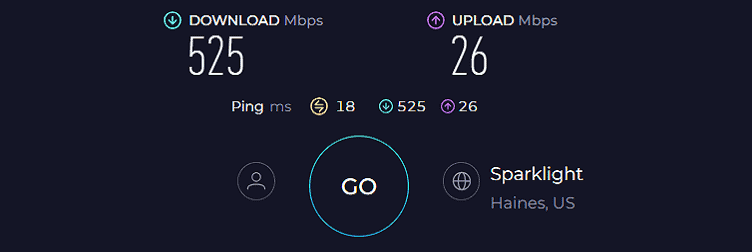
Moving far off to 40 feet, the laptop in the same setup managed respective speeds of 531 Mbps and 389 Mbps. That’s almost a 40% speed drop upon doubling the distance, but latency remains unaltered.
With the available speed, the UHD streams ran at a refresh rate of 38%, while turning on the QoS, it stooped down to 12%, which is great.
WiFi Coverage & Devices Capacity
The AXE75 boasts six external antennae with a theoretical range of 2,000 Sq Ft. In my test, the signals emitted from the router could encase every bit of my grandpa’s 100-year-old 1,500 Sq Ft house, demonstrating its excellent penetration ability.
Credits primarily go to beamforming, which, coupled with MU-MIMO and OFDMA, could connect up to 82 smart devices at once. The signals were stable, and not in a single instance, there were any major lags or latencies.
Security Features
Right out of the box, TP-Link AXE75 boasts a decent set of features with its HomeShield Basic suite. Your user credentials and network data are encrypted and secured with its WPA3 standard, which lets you browse anonymously with a VPN, and keeps the datasets safe from malicious agents with its SPI firewall.
Besides, its guest network and manual website blocking feature lets you keep the users and network safe from the dangers of the online world.
Ports & Connectivity
You don’t get any high-speed ports with this device, but there’s a fair share of Gigabit ports to get through your bandwidth-intensive tasks with ease.
Through the wired connection, I could access download speeds of up to 987 Mbps, so you can stream or game in 4K without worrying about lags or buffers.
Conclusion
The $200 price tag for a WiFi 6E router is potentially a bargain, especially when you get something like TP-Link Archer AXE75.
It offers strong performance, and its networking technologies let you establish multiple connections at once, making it a smart pick for most office setups. But its limited range limits its usage in any large space. Check out the full review.
Pros
- Excellent wireless speeds
- Uncongested 6 GHz band
- Handles multiple devices
- QoS for traffic prioritization
- Easy to install
Cons
- No multi-gig port
4. Best Dual-Band Router: ASUS RT-AX88U Pro
- New-generation WiFi 6 - Enjoy ultrafast speeds up to 6000 Mbps with the latest WiFi 6 (802.11ax) and 160MHz channels.
- Dual 2.5G ports -Traffic via 2.5G ports has top priority; flexible WAN/LAN network port configurations.
- Extreme Quad-Core CPU Power – High-performance 2.0 GHz quad-core 64-bit CPU takes computational capabilities to the next level.
- Expanded coverage – The exclusive ASUS RangeBoost Plus improves signal range and overall coverage.
- Commercial-grade Security Anywhere – Protect your home network with AiProtection Pro, powered by Trend Micro. And when away from home, ASUS Instant Guard gives you a one-click sharable secure VPN.
Next on the list is ASUS's RT-AX88U Pro, which is my top pick for a dual-band WiFi 6 router. It has two 2.5 Gbps ethernet, and four Gig LAN ports, making it a versatile option. Some of its notable features include powerful hardware, Rangeboost Plus tech, and advanced level security for free.
Speeds & Performance
The aggregated speed is 6000 Mbps with band-wise speed distribution as follows:
| 5 GHz: 4804 Mbps | 2.4 GHz: 1148 Mbps |
I tested this routing device over a couple of WiFi 6 clients with the Optimum 2 Gig Fiber plan, and the performance was above my expectations.

Over the 5 GHz band, the downloads and uploads fared at 1873 Mbps and 1237 Mbps, respectively, while the same for the 2.4 GHz band was around 1389 and 909 Mbps. Taking the client devices 50-60 feet away had a bandwidth drop of only 30%.
With these speeds, I could stream 4K content on my TV, laptop, and smartphone at the same time. I didn’t experience any lags whatsoever. Technologies like MU-MIMO and OFDMA assist in strengthening the signals traveling far away.
WiFi Coverage & Device Capacity
With a four-antenna setup, RT-AX88U Pro can impart signals is around 3,000 Sq Ft, and so my 2,500 Sq Ft test lab was filled with powerful signals everywhere. I could pair up to 55 devices at a stretch without any connection drops.
Security Features
Asus routers are known for offering advanced security. AiProtection integrates some premium features like malware removal, intrusion blocking, and malicious website detection alongside features like VPN, guest access, WPA3, and more.
So, irrespective of your network ecosystem, this keeps it secure. There are also advanced parental controls, which help block certain websites and mobile apps.
Besides, features like a kid-safe preset, internet activity dashboard, and content filter let you make sure that your kids are safe online.
Ports & Connectivity
Asus has been very open-minded in this respect, with two 2.5 Gbps ports, four 1 Gbps LAN ports, and a USB 3.0 port, enabling extensive connectivity.
Paired with the same Optimum 2 Gig Fiber plan, these ports deliver a maximum speed output of 1948 Mbps and 1514 Mbps, respectively, for downloads and uploads. The best part is there are literally zero network interferences and obstructions.
Aside from that, it boasts a USB 3.0 port to foster faster file transfer speeds. At 91 Mbps, my 1.5 GB file took around 20-25 minutes.
Conclusion
ASUS RT-AX88U Pro is a great pick for users looking for a good dual-band 2.5 GB router with top-tier features and performance. Its high throughput capacity, great coverage, multi-gig ports, and powerful hardware make it top the list.
Pros
- Dual 2.5G ethernet ports
- Commercial-grade security
- Excellent speeds & performance
- Long wireless coverage
- Range boosting technology
Cons
- Pricey
5. Best Mesh WiFi Router: Eero Pro 6E
- EERO’S FIRST Wi-Fi 6E SYSTEM - eero Pro 6E supports fast speeds and access to the new 6 GHz band when using Wi-Fi 6E devices, resulting in lower latency across your network, even for non Wi-Fi 6E devices. Backward-compatible with previous-generation eero devices.
- WIRED SPEEDS, WITHOUT THE WIRES - Game, work, or stream reliably with eero Pro 6E.*
- EERO TECHNOLOGY OPTIMIZES YOUR WIFI - Supports blazing-fast gaming across your whole-home network.
- MORE BANDWIDTH, GIGABIT+ SPEEDS - Supports network speeds up to 2.3 Gbps—including wired speeds of up to a gigabit and wireless speeds of up to 1.6 Gbps. Enables gigabit+ internet plans when using the 2.5 Gb Ethernet port.
- MORE WIFI FOR MORE DEVICES - Network coverage up to 6,000 sq. ft. and support for 100+ connected devices.
If you value reliability and range over an outright WiFi speed, then Eero Pro 6E is a great pick to fill your mid-sized space with wireless data.
It is one of the top-rated WiFi 6E mesh that blends powerful antennae with mesh support, a multi-gig ethernet, and networking technologies to satiate your bandwidth needs with ease.
Speeds & Performance
Eero Pro 6E can reach a top theoretical speed of 5400 Mbps, with the share on each frequency band as follows:
| 6 GHz: 2300 Mbps | 5 GHz: 2300 Mbps | 2.4 GHz: 800 Mbps |
As with most mesh systems, installing this Eero system was a breeze, and it took me a few minutes to get it started. Paired with my trusted AT&T 1 Gbps plan, the mesh WiFi turned in high scores in my throughput performance tests.
The score of 864 Mbps for downloads and 721 Mbps for uploads on the close-proximity tests (20 feet) stays shoulders with TP-Link Archer AXE75.

But it managed to keep its nose ahead in my distance test (45 feet) with a maximum throughput of 623 Mbps and 510 Mbps for downloads and uploads, respectively. However, the lack of QoS keeps it behind my top recommendations.
Nevertheless, gaming performance was great, with Overwatch running in 4K at 16ms ping and 85 FPS, while UHD streams had a 35% refresh rate. And none of them lagged even once.
WiFi Coverage & Devices Capacity
Being a mesh system, coverage is the USP of Eero Pro 6E. Its single unit is capable of covering 2,000 Sq Ft area, and I got two of them, thereby 6,000 Sq Ft.
To test it out, I installed the main unit in the basement while the node was on the first floor, and I never ran out of signals in my two-level 3,700 Sq Ft house and weak signals weren’t a thing.
The Pro 6E has MU-MIMO and OFDMA to somewhat support the manufacturer’s claim of handling 100 devices at a time, as in my test, the numbers maxed out at 68. That’s still great for any mid-sized corporate space.
Security Features
For free, you have the standard WPA3, VPN, guest network, SPI firewall, and auto-firmware update. Other than that, it has got a few things extra with TLS that create safe passage for data packets to travel, NAT to conserve your IP addresses, port forwarding, and cloud connectivity for added security.
For advanced security features, you gotta subscribe to the premium security suite, Eero Plus. Is it worth it?
Ports & Connectivity
Turning the white wedge-shaped box around, you’ll find only two Ethernet ports, but one of them has a maximum capacity of 2.5 Gbps.
If a wired connection is your sole priority, then opt to upgrade your internet plan up to 2 Gbps, access download speeds of up to 1.95 Gbps, and further upgrade your gaming performance. But it lacks any link aggregation support.
Conclusion
Eero Pro 6e might not be the fastest mesh kit, but it is reliable and powerful enough for any mid-sized house or corporate space. It combines a multi-gig port with a 6 GHz band to deliver high-gigabit speeds for your top-tier activities while its network optimization software minimizes network congestion.
But on the downside, there aren’t many networking ports for high-end data transfers. For more details, check out the comprehensive Eero Pro 6E review.
Pros
- Excellent WiFi coverage
- 2.5 Gig port for high-speed transfers
- Additional 6 GHz frequency
- A decent range of security features
- Great speeds
Cons
- Only two networking ports
6. Most Secure Router: Synology RT6600ax
- Expanded 5.9 GHz spectrum support enables additional high-speed 80 and 160 MHz channels
- 2.5GbE port enables support for the fastest ISPs and can optionally be configured as a LAN port
- Create and define up to 5 separate networks to segregate and contain vulnerable devices
- Parental controls, web filtering, traffic control, and threat prevention put you in control over your network
- Comprehensive VPN server solution with remote desktop and site-to-site tunneling provides flexible and secure remote connectivity
Synology RT6600AX is an exceptional pick for those looking for a highly secure router that prioritizes security and reliability over high-speed outputs. Although it boasts WiFi 6, there’s a tri-band support for seamless data transfers.
Besides, its multi-gig WAN port, long range, and a plethora of networking technologies make it a much better option than its predecessor, RT2600AC.
Speeds & Performance
As the name suggests, RT6600AX has a maximum data transmission ability of 6600 Mbps, which is shared by each band as follows:
| 5 GHz (1): 4800 Mbps | 5 GHz (2): 1200 Mbps | 2.4 GHz: 600 Mbps |
I used the RT6600AX as my default setup for almost a week, and there weren’t any issues in day-to-day use. It was paired with the AT&T 1 Gbps plan, and the speeds were measured on my Dell XPS laptop at varying distances.
To start off, I placed the device 20 feet away and could achieve respective download and upload speeds of 812 Mbps and 735 Mbps.
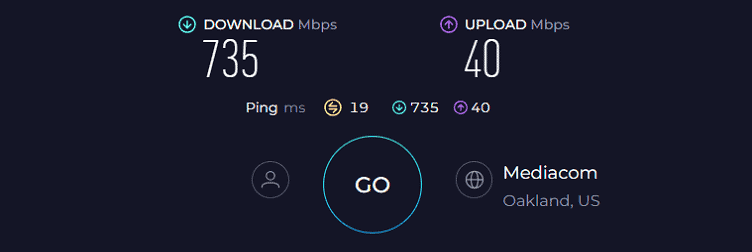
The speed differences are apparent in Pro 6E and others where you add a superior 6 GHz band, but with two 5 GHz, it does a great job in mowing through your streaming and gaming tasks.
Besides, in my long-range test, the speeds averaged 586 Mbps and 465 Mbps, respectively, for downloads and uploads. Despite a speed drop, the stability was out of the question.
WiFi Coverage & Devices Capacity
Synology RT6600AX stands out amongst the most standalone units with six high-gain antennae and a theoretical range of 3,000 Sq Ft.
I tested it at my Nashville test lab, and I wasn’t disappointed at all, as even in the nooks, the available signals let me stream YouTube videos in HD. The credit primarily goes to the beamforming tech.
Furthermore, MU-MIMO and OFDMA tech stabilize the signals on up to 52 smart devices simultaneously. These include computers, laptops, smartphones, and other bandwidth-intensive ones.
Security Features
Synology revolutionizes the security aspect of routers as it has plenty of advanced features right out of the box. Starting off, its threat prevention feature greatly enhances security and is designed to safeguard the network against online threats.
There’s a VPN+ server to let you enjoy the usual VPN features without any speed drops. Other than that, it includes periodical network scans and the usual set of features like WPA3, guest network, port forwarding, and auto-firmware updates.
Ports & Connectivity
Synology has a traditional layout of a WAN port and four LAN ports with respective capacities of 2.5 Gbps and 1 Gbps. I could access up to 1.93 Gbps speed with the former port and could play online games like Overwatch and EA FC 24 at 11ms ping and 96fps. That’s massive, even for a potent gamer.
Conclusion
To summarise, RT6600AX is a great WiFi 6 router that combines great performance with robust security features. The range and speed it delivers make it a perfect choice for any residential or commercial office setup.
But it’s more expensive and lacks in range when you put aside the Eero Pro 6E. However, if you want to learn more, check out its full review.
Pros
- Tri-band operation
- Great speeds & throughput
- Decent wireless range
- Exceptional security features
- 2.5G WAN port
Cons
- Expensive than WiFi 6E routers
7. Best for Work From Home: Linksys Hydra 6
- LEAVE THE LAG BEHIND: Linksys Hydra 6 WiFi router uses Intelligent Mesh to deliver the speed of WiFi 6, at an affordable price. From next-level gaming to streaming your favorite content, get the fastest connection to everything you do.
- THE POWER AND RELIABILITY OF WIFI 6: Experience rock solid connectivity with this dual-band WiFi 6 wireless router. An advanced Qualcomm chipset delivers the ultimate mesh WiFi 6 experience for stable streaming, and wire-like low latency
- MORE WIFI FOR MORE DEVICES: Supporting 25+ devices, and up to 2,000 sq ft, this WiFi 6 router sends and receives multiple streams of data simultaneously, providing up to 4x the WiFi capacity so it can handle more gaming and smart home devices
- EASY SETUP & CONTROL: Wireless routers set up in minutes with the free Linksys App, allowing seamless management of your WiFi mesh network system. You can view or prioritize which connected devices are using the most WiFi from anywhere.
- POWERED BY INTELLIGENT MESH TECHNOLOGY: Eliminate dead zones and dynamically maximize speed with Linksys WiFi mesh networks. Expand the range of your WiFi network by adding nodes to keep your connection going strong
It’s as simple as it gets with work-from-home routers, but fast speeds and consistent performance make the Linksys Hydra 6 an upgrade pick worth considering. It has got so much going in its favor, be it a 160 MHz channel, decent range, and more.
Besides, it rakes up serious upgrades over the model it takes over without increasing the price much to make for a perfect pick for your homes and offices.
Speeds & Performance
Linksys Hydra 6 is a WiFi 6 router with a maximum speed cap of 5400 Mbps divided among its two bands as follows:
| 5 GHz: 4800 Mbps | 2.4 GHz: 600 Mbps |
Although capable of handling 1000 Mbps, I paired Hydra 6 with a 500 Mbps plan from Xfinity, and the performance was excellent in a WFH environment.
My test system 20 feet away delivered 448 Mbps for downloads and 29 Mbps for uploads. That’s great for your high-speed downloads and 4K gaming tasks.
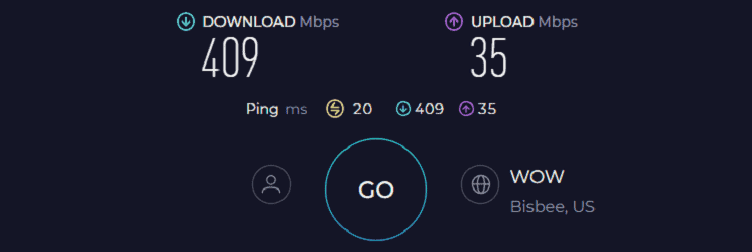
At 40 feet, the speeds were recorded at 306 Mbps and 19 Mbps, respectively. But in my week-long test, there weren’t any major lags or latencies.
WiFi Coverage & Devices Capacity
Linksys Hydra 6 doesn’t excite me with its stipulated range of 2,000 Sq Ft, which translates to around 1,600 Sq Ft in real life, but what’s great about it is the mesh tech support. You just have to get another unit to eliminate dead zones and dynamically maximize speed across your home office.
Other than that, there’s beamforming and MU-MIMO tech to support multiple connections on a single bandwidth. But the numbers didn’t go higher than 20, which was a tad of a disappointment.
Security Features
Security isn’t top-notch as in my previous recommendation, nor are there any premium features on offer.
Delving deep into the feature sheet, I found features like WPA3, VPN, guest network, and access control that deliver basic protection but don’t expect much from them. But you can always add or remove any devices using its easy-to-use app.
Ports & Connectivity
It’s good to go with the wired networking connections along the back, which include one WAN and four LAN ports, all limited to 1 Gbps, though.
There also isn’t a link aggregation support, but the wired connection is always a reliable medium to connect your high-end gaming or streaming devices. And similar is the case with Hydra 6.
Conclusion
Working from home doesn’t need high-end performance, and Linksys Hydra 6 is one of the best options for it. It delivers a basic set of features and satisfies most families with reliable connectivity with mid-range internet plans.
Any mid-sized homes should get the most out of their smart devices with a wide 160 MHz channel bandwidth and the ability to use it in a mesh network. But its limited device handling ability pushes it down to the penultimate position.
Pros
- Great speeds & throughput
- Wide 160 MHz channels
- Mesh tech support
- Easy to setup
- Reasonable price
Cons
- Middling device handling ability
8. Best for 100-300 Mbps: TP-Link Archer AX55 Pro
- Dual-Band AX3000 WiFi 6 Router: Experience incredible WiFi 6 speeds up to 2402 Mbps at 5GHz Band and 574 Mbps at 2.4GHz Band on the 160 MHz channel. Stream stutter-free 8K/4K videos, enjoy lag-free online gaming ¹ ²
- 2.5 Gbps Multi-Gigabit Connectivity: Archer AX55 Pro has 1 x 2.5 Gbps WAN/LAN port along with 1 x gigabit WAN/LAN port and 3 x gigabit LAN ports for all your expansion needs
- Vast Coverage: 4 x high-performance antennas boost WiFi signals throughout your home and Beamforming technology detects devices to concentrate signals towards them, providing a strong and reliable WiFi to every corner of your house
- Boosted Throughput: MU-MIMO and OFMDA technology works to boost throughput and efficiency of your WiFi network. MU-MIMO communicates with your router to provide multiple data streams simultaneously, greatly increasing the number of connected devices and OFDMA enables sharing a single data stream between multiple devices to further enhance the efficiency of each data stream.²
- Support for VPN Client & Server: Allow devices in your home network to access remote VPN servers without needing to install VPN software on every device.
Lastly, presenting you a cheap yet dependable router, TP-Link Archer AX55 Pro, that makes up the list with upgrades over Hydra 6, like a multi-gig port and a better range. If you're currently on a 100 Mbps to 300 Mbps plan, this one should be your ideal pick. It'll also work with any future speed upgrades.
Speeds & Performance
TP-Link AX55 Pro is a dual-band WiFi 6 unit with a maximum data transmission ability of 3000 Mbps, which is split over its bands as follows:
| 5 GHz: 2401 Mbps | 2.4 GHz: 574 Mbps |
Now when it comes to raw speeds, I tried Archer AX55 Pro with two different low-speed plans and it fared pretty well with both.
With a 300 Mbps Performance plan from Xfinity, the top speeds I managed to record from a 20-feet distance were 268 Mbps for downloads and 26 Mbps for uploads.
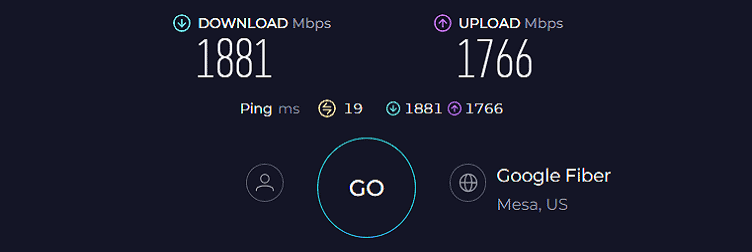
That’s really fast and could handle 29 4K streams at a time. Meanwhile, the distanced speed test at 50 feet recorded 202 Mbps and 18 Mbps, respectively.
When paired with the 100 Mbps connection from Astound Broadband, the close-range speeds clocked 79 Mbps and 16 Mbps for downloads and uploads, respectively.
Aside from a speed drop at the distances, I found a tad of instability when more than 40 devices were connected. But with its QoS feature, even 4K streaming and playing casual games was a smooth experience.
WiFi Coverage & Devices Capacity
Archer AX55 Pro claims the ability to cover up to 2,500 Sq Ft of space. Despite multiple obstructions across the house, the device managed to cover a 2,100 Sq Ft area, and as per my WiFi analyzer app, the signal strength was decent in most parts.
Furthermore, the MU-MIMO and beamforming tech lets me connect devices like laptops, computers, smartphones, smart lights, and others, totaling up to 25.
Security Features
Archer AX55 Pro, like most TP-Link offerings, has HomeShield basic security software on offer. It includes features like a guest network, SPI firewall, access control, and IP & MAC binding to deliver basic security to your network.
Besides, it lets you block a category of websites for a particular user and pause the internet at any time.
Ports & Connectivity
I was surprised by the fact that a router for under $150 gets you a multi-gig port for high-speed connections. Other than that, there’s one WAN and four LAN ports with a maximum of 1 Gbps speed cap.
So if wireless speeds don’t suffice your internet needs, plug in your devices directly to the routing device and get it going.
Conclusion
Despite being priced below $150, this one offers a wide range of benefits in wireless & wired performance, reliability, coverage, and more, firmly positioning itself into the list of top-rated wireless routers for low-tier 100 to 300 Mbps plans.
Additionally, its fundamental security features effectively protect your network from external threats, ensuring its safety. However, unstable signals at a distance and less throughput capacity compared to others have pushed it to the bottom.
Pros
- 2.5 Gig port
- Great speeds
- Decent WiFi range
- Easy to install
- Supports all plans
Cons
- Unstable signals at a distance
Frequently Asked Questions
As far as my research goes, TP-Link Deco BE22000, with a maximum of 22 Gbps speeds, is the fastest router on the market.
WiFi 7 is still at its earliest stage, with multiple of its abilities still untapped. And with not many compatible devices available yet, it won’t be smart to consider WiFi 7 routers now.
TP-Link Deco BE22000, with a maximum range of 9,600 Sq Ft, is the longest-range option as of yet.
Verdict
With the need for fast internet at its peak, it’s important to invest in a reliable and balanced router. I hope my provided recommendations helped you make a smart decision, and if not, here are my final suggestions:
- If you want the best internet router money can get, opt for ASUS ROG GT-AXE16000 with a range of top-tier features.
- If you don’t want to spend much yet need a future-proof option, TP-Link Archer AXE75 should be a go-to choice.
- And if you’re looking for a cheap yet reliable option, go for Linksys Hydra 6.
With that comes an end to my guide. I hope you understand your needs and make a choice that suits you well. Goodbye and take care!










